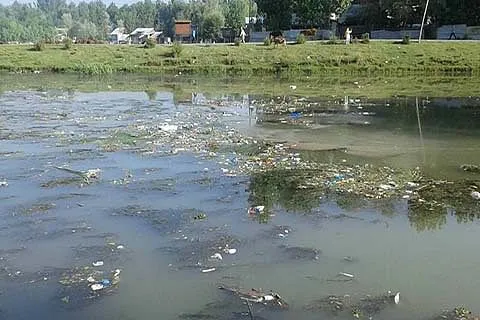Srinagar: Twelve water bodies out of 19 in Srinagar have dried up due to encroachments and official apathy.
According to the environment plan report of Srinagar district, Sumbalar Tachi, Parinag Chhaterhama, Nishat Temple Nag, Checki Dara, Ishber Astan, Kachrinag Ishber, water bodies of Ishber Kral Mohalla, Drang Mohalla Ishber, Paltan Gan Wadi, Zewan payeem, Darnar Nag and Mokdam Mohalla Zewan have been identified to have almost dried up.
“The question arises, how can we prevent deterioration and degradation of our environment? The task of conserving and preserving our environment during these modern times is Herculean,” reads an action plan report.
“The only solution to this critical environmental issue is people’s mass participation in saving the environment. Mass afforestation drives and stopping the use of fossil fuels can help solve this problem. Various gaps have been identified in each and every action area. The action plans, which are suggested, have to be implemented to minimise these gaps.”
The environment has suggested that Rs 3.07 crore is required for restoration of various water bodies of district Srinagar.
“This entire preservation and conservation cannot be done only at the administration level. The public participation and behavioural changes have to be increased manifolds to achieve the target of clean environment. And it can be achieved through mass awareness and creation of a feeling of belongingness amongst the populace.”
It has also recommended de-silting, de-weeding, strengthening embankments and banning disposal of waste into water bodies.
As per the environmental plan, seven thematic areas, which include waste management plan, water quality management plan, domestic sewage management plan, industrial waste management plan, air quality management plan, mining activity management plan and noise pollution management plan have been discussed to be worked upon for clean environment in the district, which is a hub for economic and tourist activities.
For Hokersar Wetland, the action plan has highlighted its silting, growth of weeds and poor embankments.
The administration has estimated a tentative cost of Rs 10 lakh for working on these three areas for restoring the water body.
These three areas have been also identified in Marsar Lake, for which the administration has estimated a cost of Rs 20 lakh.
For Khushalsar and Gilsar, the administration has estimated a cost of Rs 50 lakh for working on marshy land that developed due to the filling of waste material.
As per the action plan, Rs 1 crore has been estimated for Dal and Anchar lakes for de-weeding.
It highlights that these lakes are partly occupied by buildings.
The action plan highlights problems of marshy land and silting in Baba Demb and Sarband reservoir for which Rs 50 lakh and 30 lakh has been estimated for restoration. The action plan estimates Rs 43.5 lakh for restoration of these 12 water bodies which have dried up.






